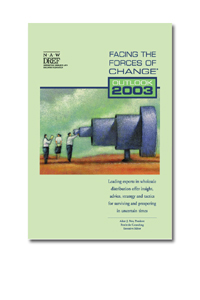
Many aspects of our world have changed since the "Facing the Forces of Change: Future Scenarios for Wholesale Distribution" report was published by the National Association of Wholesaler-Distributors' Distribution Research and Education Foundation in October 2001. Over the past year distributors and their suppliers have weathered a tumultuous and seemingly unending economic storm. In response to the weakened economy and flat or down sales, many distributors have slashed inventory, initiated hiring and salary freezes, restricted travel and, in some cases, begun layoffs. This year, those trends continue, along with these:
- Many wholesaler-distributors, particularly those serving industrial customers, are struggling with a challenging and uncertain economic environment. Suppliers and customers are facing the same difficulties.
- Global manufacturing competition continues to lower the real-dollar prices of products. As a result, generating margin dollars from product markups is becoming more difficult than ever. This deflationary environment rewards companies that can quickly shrink operating expenses.
- Merger-and-acquisition activity has slowed as business prospects have become uncertain and consolidators digest their prior acquisitions. As a result, business owners face greatly reduced business valuations and fewer possibilities for the sale of a business.
Given the rapidly changing marketplace, NAW/DREF and Pembroke Consulting want to give wholesale distribution executives an interim update on the key issues identified in the original report. Through my strategy consulting work, I have learned that distribution executives recognize the underlying strength and resilience of the U.S. economy. Moreover, innovative strategies can prepare management to act differently once the marketplace changes. Today, more than ever, business strategy needs to be forward-looking as well as pragmatic.
"Facing the Forces of Change Outlook 2003" is a diverse and powerful collection of insights from several of the wholesale distribution industry's leading thinkers. Each contributor uses "Facing the Forces of Change" as a jumping-off point for looking forward and understanding the near-term future of wholesale distribution. I worked with each of the contributors to help them augment Pembroke Consulting's original research with their own experiences and ideas.
Each chapter provides you with the author's assessments and predictions about a particular topic along with specific action steps and recommendations for your business. All of the contributors draw on multiple insights and scenarios from the most recent edition of "Facing the Forces of Change." To get the most out of this book, we recommend that you purchase the complete report as a reference and guide. It is available online at www.nawpubs.org.
Seven Forces Of Change
The "Facing the Forces of Change" series, which dates back to 1982, remains the only report analyzing ever-evolving marketing channels and supply chains from the perspective of wholesale distribution. My colleagues and I at Pembroke Consulting were fortunate to have the opportunity to conceptualize, research, and write the most recent edition of this prestigious series, which drew upon an unprecedented breadth of research.
- In-depth interviews with 75 leading consultants, journalists, financial analysts, educators and industry association executives.
- Nearly 1,600 responses to an extensive online survey of senior wholesale distribution executives along with their suppliers and customers.
- Case-studies of successful wholesaler-distributor strategies.
- Research into industries undergoing leading-edge change.
- Pembroke Consulting's proprietary knowledge base.
"Facing the Forces of Change: Future Scenarios for Wholesale Distribution" went beyond previous reports by analyzing trends and forecasts based on the five types of customers to which a wholesaler-distributor sells products and services. Many of those trends are already playing out. Here are seven of the most important trends that the Outlook 2003 contributors draw upon:
Wholesaler-distributors will play an important role in marketing channels and supply chains. As we enter the 21st century, wholesale distribution remains an important force in the economy. In 2000, sales of all wholesaler-distributors reached $2.8 trillion. The industry has been growing at a 5.6% annual rate since 1991. Wholesale distribution contributes 7% of U.S. national income and accounts for about one in every 20 U.S. jobs. Wholesale distribution still represents the most significant channel to market for manufacturers and the most important supply chain for customers, particularly when there are many small customers and a wide variety of manufacturers. Consider the fact that more than 75% of all product sales occur through distributors in a broad range of industries, such as building materials, foodservice products, pharmaceuticals and industrial MRO products.
Online ordering will be adopted slowly. Customers will adopt new e-business technologies when it benefits them and limit technology usage when the technology does not help them. In "Facing the Forces of Change," we found that the percentage of orders received online will grow substantially, but not overtake more traditional methods within the next five years. In other words, the phone, fax and sales rep will remain common modes of order placement despite the Internet and other new technologies.
Fee-based services will grow as an important source of revenue and profit. Many distributors have fallen into a trap by providing services beyond product fulfillment "for free" to generate competitive advantage and become a preferred supplier. Instead of making up the additional costs through product margin on increased volume, distributors have been squeezed by powerful customers and deflationary product economics.
The introduction of fee-based services is emerging as a logical evolution of the traditional gross margin pricing model for distributors. A shift from markup margins on product sales to service fees provides a more direct and accountable means of measuring value and functions in the supply chain. It unbundles traditional pricing models by splitting product prices from the costs of services. Distributors also have the opportunity to finally get paid for the service activities they provide to customers. Yet the ultimate success of fee-for-service pricing remains uncertain. Today, many buyers still have a very low willingness to pay for services that they used to get for free, even if they acknowledge the economic logic behind the concept. Some customers are already denouncing the fee-based service trend as self-serving behavior by distributors.
The distribution salesforce will remain under increasing pressure. As customers begin to educate themselves by relying on the manufacturer for product information, the value of a distributor's salesforce is being reduced in the eyes of customers.
Smaller customers, such as contractors or small industrial buyers, typically rely on a distributor's inside or outside salespeople to obtain technical and business assistance in product selection and use. However, customers increasingly value the Internet as a source of product information, even though online order placement will only grow slowly.
As "Facing the Forces of Change" predicted, customers and purchasing managers are increasingly using the Internet to bypass sales channels and directly gather product specifications, warranty and rebate information, material safety data sheets and potential suppliers. The Internet overcomes traditional cost limitations of geography, time and number of customers, giving manufacturers an affordable way to take greater control over the information flow to the customer.
In other words, online technologies are giving customers lower-cost, higher-service alternatives to a wholesaler-distributor's salesforce. As a result, the role and activities of the salesforce of the future will be significantly different from today's. When the role of a distribution salesforce has declined, as in channels such as pharmaceuticals or automobiles, distributor margins also drop, since the intermediary is adding less value.
Customers will continue rationalizing their buying process. Customers will continue to concentrate their purchases through fewer distributors. This trend toward vendor rationalization by customers is expected to continue as customers seek additional efficiencies in their supply relationships and buying processes. Wholesaler-distributors will either consolidate or join alliances in response.
Vendor rationalization represents just one of the many changes occurring in business procurement in an attempt to improve inbound supply chain efficiencies. "Facing the Forces of Change" forecasts that business customers will continue to consolidate supply contracts, install e-procurement systems and experiment with reverse auctions.
Manufacturers will explore new distribution options. Another strategic uncertainty highlighted in "Facing the Forces of Change" is the emergence of new competitors to wholesale distribution in the physical movement of goods to customers.
Third-party logistics providers, who have traditionally been package-handling enterprises, are moving "inside the box" by offering product-handling services such as warehouse management, order processing, pick/pack/ship, just-in-time parts delivery and many other wholesale distribution functions. Manufacturers are also turning to logistics companies to provide "master distribution" services to the highly fragmented industrial distribution channel.
The implications of this logistics shift have already been felt in many lines of trade. Local distributors are able to stock less inventory and rely on the manufacturer - via supply chain logistics companies - to drop-ship to customers on their behalf. Manufacturers are reducing or eliminating stocking requirements for their authorized channel partners. And most important for wholesaler-distributors, manufacturers can more easily serve direct business.
Manufacturer-distributor relationships will evolve. Manufacturers and distributors continue to rely on each other's actions and resources. Simultaneously, each side struggles to maintain autonomy and control over its own operations in this era of dynamic uncertainty. This mutual dependency creates conflicts about direction, strategy and commitments. Business relationships between manufacturers and distributors are not altruistic, nor should they be. Both parties need to perceive a benefit from the relationship.
The seven trends highlighted above suggest a more uncertain era for manufacturer-distributor relationships. Given new routes to market, many distributors are uncertain about whether their manufacturers will be investing in traditional channels during the next five years.
At the same time, manufacturers know that the Internet can be a viable source of content but still be poorly suited to the buying behavior and requirements of customers. Few customers are willing to migrate their entire purchasing process to a direct relationship because it often means sacrificing local service, technical support and complex fulfillment requirements.

Five Types Of Customers For Distributors
- Contractors
- Institutions
- MRO (Maintenance, repair and operations buyers)
- OEM (Original equipment manufacturing buyers)
- Retailers
